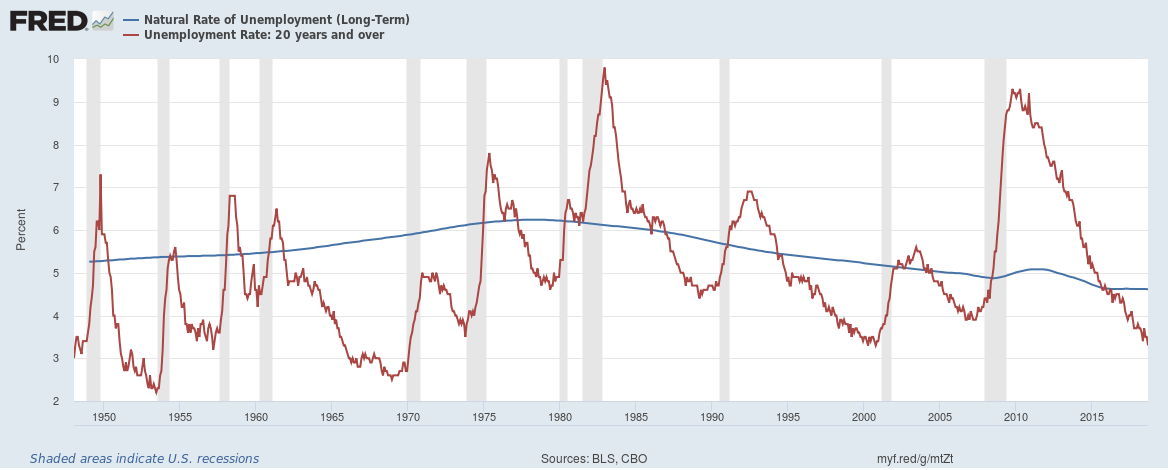Natural Rate of Unemployment
Natural rate of unemployment is the long-run unemployment rate around which the actual employment rate oscillates. It is the combined effect of frictional unemployment and structural unemployment.
Unemployment rate increases during recessions and decreases during expansions but is never zero. It is because some level of frictional unemployment and structural unemployment exists during all stages of a business cycle. Frictional unemployment arises due to the time it takes in matching workers to jobs and the structural unemployment is the unemployment that exists due to factors such as minimum wage, unionization and efficiency wages which keep the market from reaching equilibrium.
Natural rate of unemployment (un) equals the sum of rate of frictional unemployment (uf) and rate of structural unemployment (us):
$$ \text{u} _ \text{n}=\text{u} _ \text{f}\ +\ \text{u} _ \text{s} $$
Actual unemployment rate (ua) differs from the natural unemployment rate (un) due to fluctuations in the cyclical unemployment (uc), the unemployment that results from changes in overall economic activity.
$$ \text{Actual Unemployment Rate}\ (\text{u} _ \text{a})=\text{u} _ \text{n}+\text{u} _ \text{c} $$
Cyclical unemployment is positive and actual unemployment is higher than the natural unemployment rate during recessions. On the other hand, during economic booms the cyclical unemployment rate is negative and actual unemployment rate is lower than the natural rate of unemployment as shown the graph below:

(U.S. Congressional Budget Office, Natural Rate of Unemployment (Long-Term) [NROU], retrieved from FRED, Federal Reserve Bank of St. Louis; https://fred.stlouisfed.org/series/NROU, December 21, 2018.)
Changes in Natural Rate of Unemployment
It is true that the natural rate of unemployment is the long-run measure of unemployment, it doesn’t mean that is a constant. Natural rate of unemployment changes in response to changes in factors that affect frictional unemployment and structural unemployment, such as demographic changes, minimum wage, unionization, efficiency wages, etc.
Demographic Changes
Since frictional unemployment depends on the age and experience level of workers, a change in overall composition of work force changes its frictional unemployment rate and hence its natural rate of unemployment. An economy will high proportion of young worker will tend to have higher natural unemployment rate. It is because younger workers are more likely to switch jobs or being laid-off.
Government Policies such as Minimum Wage
Government policies such as minimum wage, job training, etc.
A minimum wage tends to increase natural rate of unemployment because it creates a price floor in the labor market which stops the market from reaching market-clearing wage level. This causes firms to hire less workers and results in an increase in structural unemployment which in turn increases natural rate of unemployment.
Some government policies such as job training, etc. tend to reduce natural rate of unemployment because they reduce frictional and structural unemployment by allowing workers to obtain skills that are in demand and increasing their productivity which makes it attractive for firms to hire them at the high minimum wage.
Unionization
Collective bargaining tends to increase natural rate of unemployment. It is because unionized work force can succeed in locking-in above-equilibrium wages and other benefits. This reduces the number of workers hired by firms. Such a below-equilibrium availability of jobs causes structural unemployment which is a component of natural unemployment.
by Obaidullah Jan, ACA, CFA and last modified on